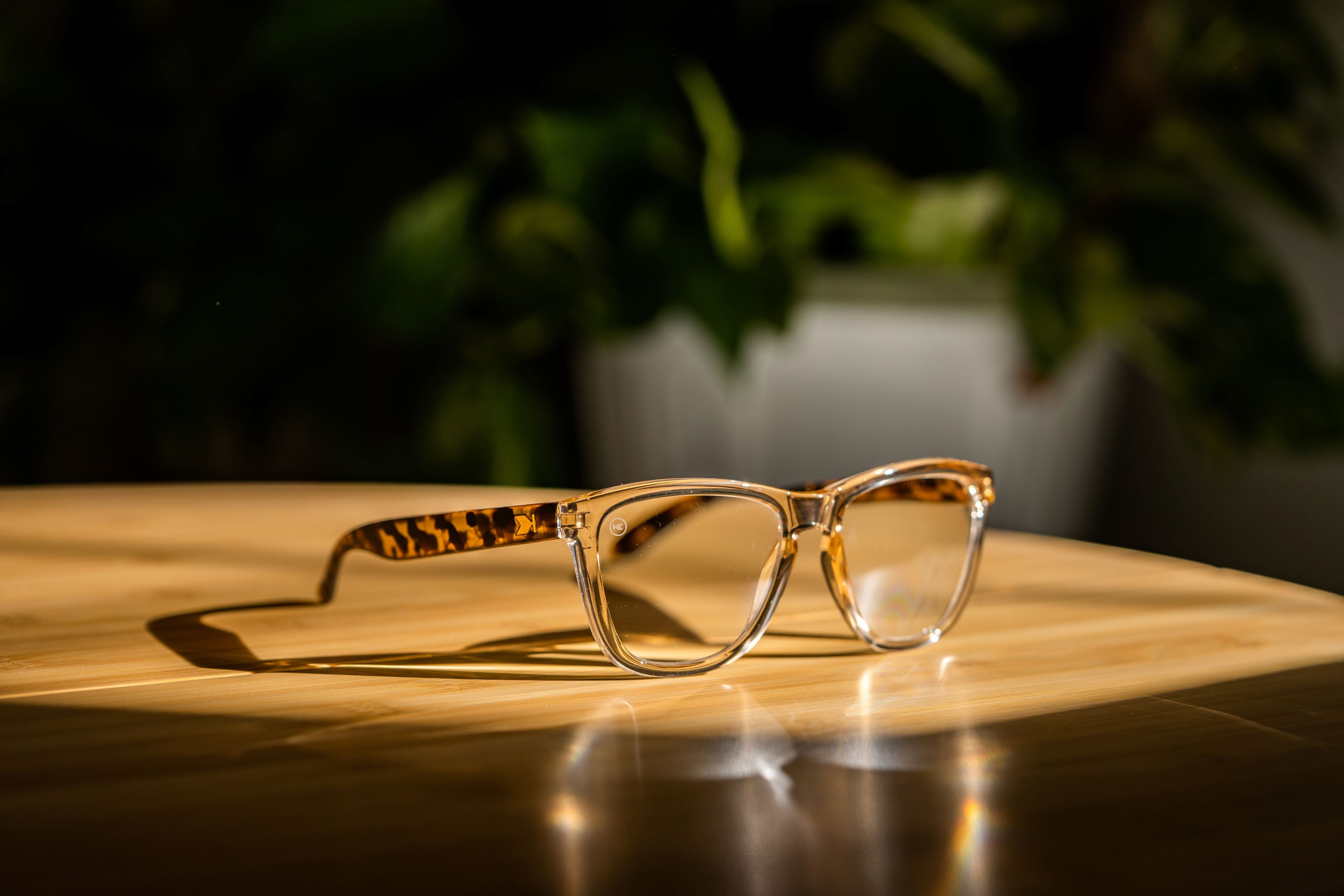The worth of prescription shades, also known as Rx shades, depends on the wearer. Do you want to see better when you’re outside? Avoid uncomfortable eye strain? Protect your eyes from harmful UV rays? Then, yes, sunglasses with prescription lenses are definitely worth it.
With around 50 options across a range of frame styles and colorways, we’re sure to have a pair that suits your unique sense of style. Let’s look at exactly what you get when you custom-order Knockaround shades with prescription lenses.
A DEEP DIVE INTO KNOCKAROUND PRESCRIPTION LENSES
Prescription sunglasses may not appear all that complicated. But there are a lot of important features, created with cutting-edge technology, packed into those simple-looking lenses. Knockaround prescription sunglasses have:
High-index lenses. Why does that matter? Thinner and lighter than regular eyeglass lenses, high-index lenses bend light more efficiently. With traditional lenses, the lens thickness needs to increase to correct the refractive error and allow the wearer to have clear vision. That thickness creates a bulky pair of specs! But you can get that same optical power and a slim, sleek look (and lower weight) with high-index lenses.
Digital lenses. Huh? For the uninitiated, digital lenses are, as the name suggests, digitally enhanced. They provide a greater degree of clarity compared to lenses that are made traditionally. Digital lenses offer greater contrast sensitivity, improved peripheral vision, and sharper image quality. With traditional lenses, which are surfaced on one side, the wearer’s best vision lies at the lens center. Digital lenses are surfaced on both sides and provide a wider field of optimal vision.
Polarized lenses. If you thought polarization was just for standard shades, think again! Prescription polarized lenses are becoming increasingly popular. With good reason. People who need glasses for everyday use can spend much of those days in the sun. From strolls down the street to long-distance drives, it’s always a good idea to protect your eyes from potentially harmful ultraviolet light. And that’s where polarized lenses come in. Knockarounds have full UV400 protection, blocking up to 100% of UV light.
Polycarbonate lenses. Dubbed the “gold standard” for prescription glasses, polycarbonate lenses are strong, resilient, and lightweight. Thinner and lighter than glass or traditional plastic lenses, polycarbonate lenses are often the choice for safety glasses, sports goggles, and children’s eyewear. How much stronger are they? Ten times stronger than glass and regular plastic. Making polycarbonate one of the most impact-resistant lens types you can buy. And they’re about 30% thinner than glass and regular plastic lenses.
Backside anti-reflective coating. To some, that might sound kind of backward. Literally. Shouldn’t the anti-reflective coating (AR) be on the front of the lens? Not always. With prescription glasses, the anti-reflective coating on the back of the lens guards against back glare. That’s light that bounces off the back of the lens and goes into the eye. Unless there’s an AR coating to stop it. Without this backside AR coating, you may see a reflection of your eye in the lens. With the AR coating, vision is clearer in a range of lighting situations.
Scratch-resistant coating. While you may want to protect any pair of shades you buy, you’re probably particularly concerned about prescription glasses. And that’s where a scratch-resistant coating comes in handy. Although no glasses are 100% scratch-proof, a scratch-resistant coating puts a hard surface on the lens to make it more durable. So dropping your glasses on the floor or inadvertently leaving them face down on a table won’t likely leave lasting marks on the faces of the lenses.
To further protect your glasses against everyday wear and tear, be sure to clean them with a microfiber cloth and store them in a pouch or a soft case.
DRIVING WITH PRESCRIPTION LENSES
There are some times when driving while wearing sunglasses isn’t such a great idea. Like at night. Or in a heavy rainstorm. But when the sun is shining, it’s almost always a good idea to wear a pair of shades when you are out on the road. And if you need to wear glasses while driving, the need for prescription sunglasses is even more important.
Stop squinting behind the wheel! It could be dangerous. Beyond basic road glare, drivers often experience bright reflections from other cars, buildings, bodies of water, and more. This all adds up to a massive amount of light hitting the eye’s retina, overwhelming it. Often, the retina can’t close enough to reduce the level of light coming into the eye. The body’s natural reaction is to squint and lower the amount of incoming light. Beyond impeded vision, constant squinting can cause nausea and headaches. All are remedied by a simple pair of prescription shades!
THE BENEFITS OF PRESCRIBED SUNGLASSES
No more clip-on sun shields. You can say good riddance to those things! While clip-on sun shields are practical, let’s face it, they’re kind of annoying. You have to remember where they are. Protect them against scratches while you’re not wearing them—which is most of the time. They add extra weight and bulk to your glasses. And as for style? Well, clip-ons aren’t exactly the most fashionable of accessories. So why use clip-on shades over your prescription glasses when your prescription glasses can be shades?
Lens choice. With regular prescription glasses, there’s one choice: clear. While you can get clear prescription Knockarounds, and that’s a good choice, you’re not limited to one option. With our prescription shades, you can choose from five different tints, including moonshine, amber, smoke, and silver.
Prescription sunglasses can prevent headaches caused by direct sunlight. Lots of people have light hypersensitivity, also known as photophobia. It’s a common cause of migraines, and bright sunlight can trigger and worsen a headache.
Prescription shades can reduce eye strain, causing temporary but uncomfortable pain in the eyes. Sunglasses can also protect the areas close to the eye, lowering the chances of wrinkles and skin cancer around your eyes.
Isn’t it time you had a pair of polarized prescription sunglasses? Getting yourself a new pair of custom-made RX sunglasses is just a few clicks away!
Written by William McCleary for Knockaround








How Much Are Prescription Sunglasses?
Game-Changing Lens Tech: Knockterra™ VS. Knockterra+™